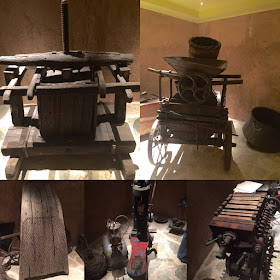The day's schedule had us traveling by motor coach to the outskirts of Athens to visit the Museum of Wine in Pallini where we would: meet the producers who comprised the Wines of Athens organization; be taken on a tour of the museum; taste a selection of wines; and then have lunch with the producers and their wines.
After a relatively short ride, we arrived at the museum.
 |
| Archways separating the pool from the Conference Center and Museum |
 |
| Conference Center. Museum is on basement level. |
 |
| Stonework on one of the walls of the conference center. |
 |
| A mashup of some of the artifacts in the museum |
We were welcomed on behalf of the producers by Vasilis Papagiannakos, owner of Domaine Papagiannakos and President of the Wines of Athens.
 |
| Ted Lelekas introducing the #Winelovers to the Wines of Athens Producers. Vassilis Papagiannakos is immediately behind Ted. |
The Wines of Athens is not an official appellation. Rather, it is an association of producers located in the eastern portion of Attica who have banded together to take advantage of the physical proximity to Athens, one of the global powerhouses in terms of tourist destinations. The map immediately below shows Attica's geographic position in Greece and the following graphic identifies the producers included in the Wines of Athens and their specific geographic locations. Before I continue I will take a moment to provide a brief overview of the environment within which these producers operate.
 |
| Source: europa-planet.com |
The producers in the Wines of Athens association are located in the eastern portion of the Vineyards of Attica, one of the most important vineyards in all of Greece, extending as it does, over 6500 ha of the region's territory. The climate of the region is warm and dry with cooling effects provided by the constant sea breeze, the Meltemi wind, and cool winds from the mountain. In the Wines of Athens coverage area similar conditions prevail with an average of 300 days of sunshine per year and average temperature of 18℃. Rainfall levels are very low but irrigation is rarely utilized.
There is a wide variation in soil composition in the Vineyards of Attica with clay domination in the east and calciferous constructs dominant in the west. According to Vassilis, the soil in the Wines of Athens production area has a high content of limestone with patches of clay but the Mylonas vineyard characterizes its soil as sandy clay over limestone with some sites containing some schist or gravel.
The Vineyards of Attica are best known for their whites with fully 80% of the plantings dedicated to varieties of that ilk. The region covered by the Wines of Athens comports with that model with 75-80% of its wines being white. Of the white varieties, Savatiano is dominant due to its high resistance to the dry, hot conditions and its yield of "elegant, well-balanced wines." The varieties planted in the region are shown in the table below.
Table 1: Vineyards of Attica varieties
| White | Red | |
| Indigenous | Savatiano | Agiorgitiko |
| Assyrtiko | Mandilaria | |
| Malagousia | Limniona | |
| Roditis | ||
| Athiri | ||
| Aidani | ||
| International | Chardonnay | Merlot |
| Sauvignon Blanc | Cabernet Sauvignon | |
| Ugni Blanc | Carignan | |
| Semillon | Syrah | |
| Tempranillo | ||
| Grenache Rouge | ||
After our tour of the museum, we filed into a large room where the producers had set up their wines for us to consider. I did not get to taste all the wines fully (sorry Ana Aga) as the conversations at the first two tables that I visited sucked up most of my time. But, that is a personal problem. Given this assymetrical distribution, I will focus on the wines of Mylonas Winery, the producer that sucked up most of my time.
At the tasting we were treated to Savatiano vertical running from 2012 to 2015. I found the 2015 to be herbal and savory with a slightly retsinated character. The 2014 exhibited chammomile, savory elements, with hints of white pepper and white flower. Balanced on the palate with an excellent texture. The 2013 showed dried white flowers on the nose and a stemminess on the palate. The 2012 showed savory herbs, iodine, lemon rind, burnt orange, and a hint of rosemary on the nose. Expressive. Savory on the palate with a nice round mouthfeel and a drying herb finish.
I tasted the Malagousia and caught tropical notes initially. When tasted later on in the day, however, this wine was stellar and balanced and showed more brightness than it had previously. I found the Assyrtiko to have a grapefruit character along with a spiciness. Not interesting from my perpective. The 2015 Retsina was reminiscent of the Tears of the Pine as described in my blog post on the topic but I must say that I tasted some Tears of the Pine at dinner later that night and it was a wine that I did not remember.
After the tasting we repaired to lunch and conversation with the winemakers. It had been a wonderful, educational trip. Thank you Wines of Athens. Thank you Ted
©Wine -- Mise en abyme


No comments:
Post a Comment